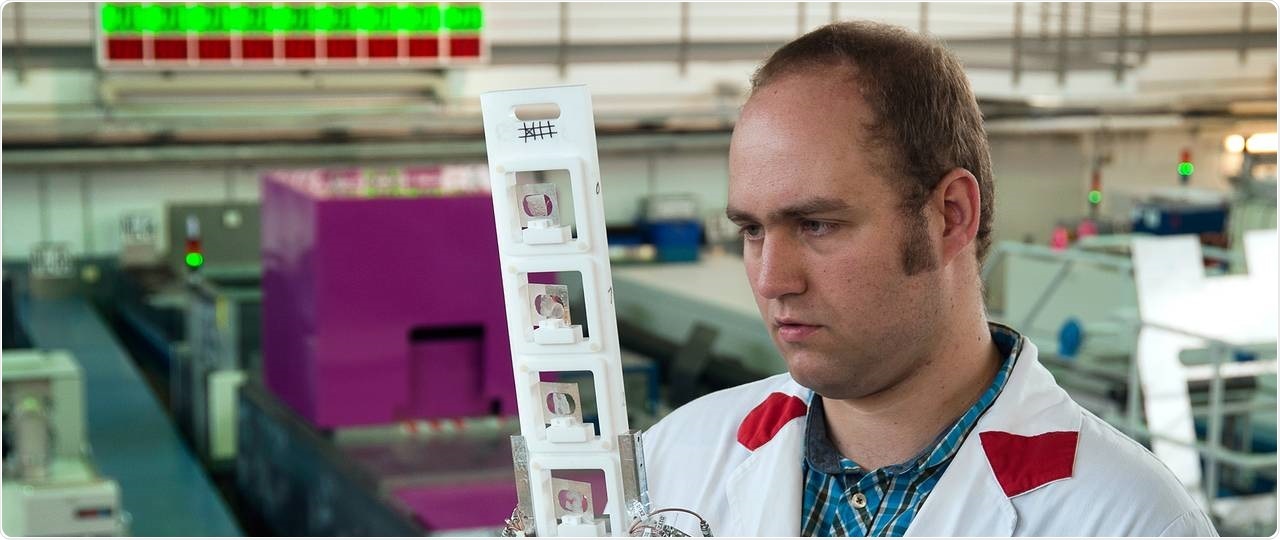Depressive diseases are among the most common illnesses in the world. The reasons are complicated and, as of now, only partly known. Lithium, a trace metal, tends to play a part.

With the PGAA-instrument in the Research Neutron Source Heinz Maier-Leibnitz (FRM II) of the Technical University of Munich Josef Lichtinger examines the lithium distribution in brain samples. In his hand, he holds the self-developed detector with the tissue sections. Image Credit: Wenzel Schürmann/Technical University of Munich (TUM).
Using neutrons from the Technical University of Munich’s (TUM) research neutron source, a team of researchers has now shown that the distribution of lithium in the brains of depressed individuals differs from the distribution present in healthy humans.
All of us are familiar with lithium from rechargeable batteries. The majority of people consume lithium from their drinking water on a regular basis. International research also found that a higher natural lithium level of drinking water correlates with a lower suicide incidence among the population.
For decades, lithium salts at much larger doses have been used to treat depressive disorders and mania. But the precise function of lithium in the brain remains unclear.
To create a method for specifically determining the distribution of lithium in the human brain, physicists and neuropathologists from the Technical University of Munich collaborated with forensic medical specialists at Ludwig-Maximilian-Universität München (LMU) and a specialist team from the Research Neutron Source Heinz Maier-Leibnitz (FRM II).
The researchers hope to be able to draw therapeutic implications as well as obtain a deeper understanding of the physiological mechanisms involved in depression.
Neutrons detect the slightest traces of lithium
The researchers examined the brain of a suicide patient and compared it with the brains of two control subjects. The study was based on the ratio of lithium concentration in white brain matter to the concentration in gray brain matter.
The researchers studied 150 samples from different brain areas, including those likely responsible for processing thoughts, to determine where and how much lithium is found in the brain. The researchers used the FRM II Prompt Gamma-Ray Activation Analysis (PGAA) instrument to irradiate thin brain parts with neutrons.
One lithium isotope is especially good at capturing neutrons; it then decays into a helium atom and a tritium atom.”
Dr Roman Gernhäuser, Central Technology Laboratory, Department of Physics, Technical University of Munich
The two decay products are detected by detectors behind and in front of the sample, providing information on the precise location of the lithium in the brain section. Since the concentration of lithium in the brain is normally exceptionally low, determining it is often difficult.
Until now it wasn’t possible to detect such small traces of lithium in the brain in a spatially resolved manner.”
Dr Jutta Schöpfer, LMU Munich Institute for Forensic Medicine
“One special aspect of the investigation using neutrons is that our samples are not destroyed. That means we can repeatedly examine them several times over a longer period of time,” said Gernhäuser.
A significant difference between healthy and depressive patients
“We saw that there was significantly more lithium present in the white matter of the healthy person than in the gray matter. By contrast, the suicidal patient had a balanced distribution, without a measurable systematic difference,” said Dr. Roman Gernhäuser.
“Our results are fairly groundbreaking because we were able for the first time to ascertain the distribution of lithium under physiological conditions. Since we were able to ascertain trace quantities of the element in the brain without first administering medication and because the distribution is so clearly different, we assume that lithium indeed has an important function in the body,” reported Schöpfer.
Just a beginning
Of course the fact that we were only able to investigate brain sections from three persons marks only a beginning. However, in each case we were able to investigate many different brain regions which confirmed the systematic behavior.”
Dr Roman Gernhäuser, Central Technology Laboratory, Department of Physics, Technical University of Munich
“We would be able to find out much more with more patients, whose life stories would also be better known,” concluded Gernhäuser, adding that it might then be possible to answer whether the deviating lithium distribution of depressed people is a cause or a result of the disease.
Source:
Journal reference:
Schoepfer, J., et al. (2021) Position sensitive measurement of trace lithium in the brain with NIK (neutron-induced coincidence method) in suicide. Scientific Reports. doi.org/10.1038/s41598-021-86377-x.